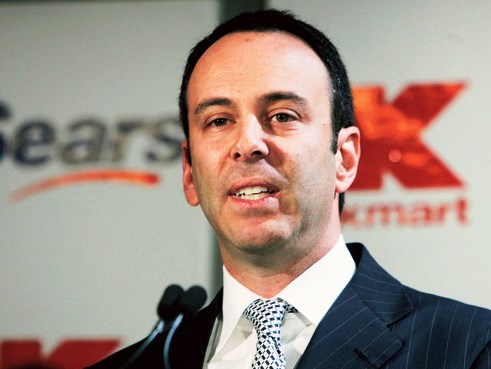
Sears chairman/CEO Edward Lampert brought investors up to speed on the company’s progress and strategies this morning in one of his intermittent and revealing open Chairman’s Letters, which is presented here in its entirety.
Chairman’s Letter
February 26, 2015
To our Shareholders, Associates and Members,
The year 2014 was one of massive transformation. One after another, major American institutions sought to fundamentally change the way they interact with their customers, in most cases trying to catch up to new ways that people choose to access products and services. In most instances, these changes were puzzling to people who don’t spend a lot of time focusing on what change looks like up close.
For Sears and Kmart, after years of work at becoming a fully integrated retailer that meets the needs of our members wherever, whenever and however they want to shop, we didn’t slow down – we sped up. We’re anticipating and adapting to the way members and customers shop, not by guessing what the next big thing might be, but by working to better understand the members we serve through data that allows us to know not only what but also why they buy and then creating experiences around that.
This isn’t new for Sears. An article in the October 2014 issue of Harvard Business Review, “Sears Has Come Back from the Brink Before,” detailed how Sears found its mail-order catalog business falling into crisis in the 1920s as America changed from a predominantly rural country and everything from cars to national radio advertising left Sears rudderless. Then Sears started using census data to anticipate where potential customers were moving; few if any others did this. Using this information, the first Sears store opened in Chicago in 1925. By the time suburbs started being built after World War II, Sears had become the icon for big retail and an anchor tenant in malls that were developed around the country.
Time and again, people have proclaimed our company all but dead. As I wrote in a blog post late last year, in 1988 our hometown business journal wrote a devastating 14,297-word eulogy for Sears. Virtually all of the companies that Sears was allegedly trailing back then are now gone and forgotten. Many others have merged or simply closed.
These old stories got it partially right. Had we not embarked on a course change; had we not, especially in recent years, started to creatively disrupt ourselves; Sears and Kmart would probably be no more than a treasured American memory.
Without the aggressive steps we have already taken to transform Sears Holdings from the predominantly brick-and-mortar retailer it once was to a best-in-class multi-channel integrated shopping experience for our members, we would be stuck on the same path that has claimed retailers like Circuit City, Borders, Radio Shack and others.
Instead, we’re innovating and moving forward. Readers of past letters and my other blog posts know all about our efforts to transform not just turn around our business. The financial results certainly are not where we want them to be yet but we did see our performance trend improve in the third and fourth quarters of 2014. The percentage of our sales coming from Shop Your Way members is high and staying strong. Most importantly, in 2014 we gave ourselves the resources to dig deeper and fuel our ongoing transformation.
2014 IN REVIEW
We ended 2014 on an upbeat note. Our fourth quarter results improved materially from last year, continuing the pattern that we saw in the third quarter and reversing the negative trends from the first half of the year. We are primarily focused on profitability instead of revenues, market share and other metrics which relate to but don’t necessarily drive profit. This means we will be making material changes in some of the underlying business models that have been challenged for many years, such as Consumer Electronics, where we have experienced significant losses since 2010. We intend to continue to operate in most of these businesses, but with a very different approach to serving our members than in the past. This change in approach may dampen our sales as we make the transition but it should also reduce the risk of material profit declines.
We believe that our focus on profitability will contribute to a meaningful improvement in performance in 2015 and beyond, and we are seeing early signs of this progress as part of our most recent quarterly results. In the fourth quarter of fiscal 2014 we had domestic Adjusted EBITDA of $125 million, which represents an improvement of $217 million versus the fourth quarter of 2013. This improvement was largely driven by an increase of $71 million in comparable gross margin dollars combined with expense reductions of $239 million.
We will continue to take actions to increase our financial flexibility to meet all of our obligations while funding our transformation. To this end, in fiscal 2014 we raised approximately $2.3 billion from a variety of asset sale and financing activities, including the spinoff of Lands’ End, the sale of a significant portion of our stake in Sears Canada and the issuance of Notes and Warrants in November.
A closer look at some of the revenue figures illustrates why we think it’s more important to focus on profitability. Revenue for the fourth quarter was down approximately $2.5 billion year-over-year but only a percentage of that was tied to declines in comp store performance ($313 million). Most of the decline in revenue, about $2.1 billion, comes from assets we sold, spun off or closed. In October, we successfully completed a rights offering that means Sears Canada’s revenue (and operating expenses) will no longer appear on Sears Holdings’ financial statements. In April, we successfully completed the spin-off of our Lands’ End business to shareholders. Throughout the year we closed underperforming stores, many of which had been operating at significant losses for far too long.
My team and I wrote more about these moves here, here and here, and many of you reading this letter now own shares of Sears Canada and Lands’ End that were distributed through these actions. Making use of these assets in different ways than we have in the past was, we think, the right way to allow us to focus on and invest in Sears Holdings’ transformation.
Sears Holdings borrowed $400 million in September to provide additional liquidity through the holidays. This loan was secured by only 25 of our approximately 1,700 properties. Much was made about the fact that it was a secured loan (we explained why here) but this enabled Sears Holdings to borrow money at far cheaper rates than it otherwise could have. In fact, it allowed Sears Holdings additional time to generate longer-term liquidity by monetizing its Sears Canada stake and to put in place a longer-term debt offering (the Notes and Warrants), proactively highlighting to our vendors that we were addressing their concerns about liquidity through the holidays.
EXPLORATION OF A REIT
We are continuing our efforts to develop Sears Holdings as a membership company, without the significant asset intensity of its traditional retail business. To this end, we announced in November that we have been exploring the formation of a Real Estate Investment Trust (REIT) to purchase some of our properties and to manage them as a pure real estate company. While not yet final, we are proceeding towards its formation and separation which is projected to occur in the first half of this year. We are currently targeting between 200 and 300 Sears stores to be sold to the REIT with expected proceeds to Sears Holdings in excess of $2 billion.
We anticipate that the REIT will continue and accelerate many of the activities that we have been pursuing over the past several years. Specifically, we have been working to partner with other retailers and mall owners to enable us to reduce the operating footprint of our stores to smaller but still significant spaces, while leasing part of the store to retailers who will bring increased foot traffic and relevance to our locations.
A completion of a REIT transaction has the potential to significantly transform our capital structure toward one that is more flexible, long-term oriented and less dependent on inventory and receivables. We would hope to maintain a long-term presence in each location while allowing Sears Holdings to still have the flexibility to make strategic business decisions should those locations prove unprofitable for Sears Holdings in the future. We believe that many locations can be repurposed with or without Sears Holdings as an anchor, which would give the REIT the potential for value creation as well as downside protection if Sears Holdings were unable to continue to operate certain stores profitably.
OTHER WAYS WE’RE USING OUR STORES DIFFERENTLY
We have highlighted specific examples of how we are reconfiguring our stores so that observers will better understand our plans. In fact, we have received positive feedback from investors, local communities, members and our own associates as we upgrade our sites with partners such as Whole Foods, Nordstrom Rack, DICK’s Sporting Goods, Forever 21 and Primark. Each of these retailers has its own attributes and requirements, and we have demonstrated flexibility and creativity in working with each of them to forge deals that work for both of us. They form the foundation for similar deals in the future and are part of how Sears Holdings is driving the innovation and modernization of the U.S. mall industry.
OUR CONTINUAL INNOVATION
As longtime readers of these letters know, Sears Holdings has been a trailblazer for testing out new ideas to both respond to and influence changes in the way customers are shopping in light of new digital, mobile and social technologies. We continued to roll out more industry-leading innovations in 2014.
Shop Your Way. The Shop Your Way program is unlocking value from our most engaged members – those at the center of our transformation who make the most frequent trips to our stores and web sites. Shop Your Way helps them save time and money and rewards them for their loyalty. While there remains much work to be done, there are encouraging signs that indicate that we are increasing the value of our most loyal segment of members. Our best members, those who visit our stores at least four times every 12 months, are increasing their business with us in terms of both sales and margin dollars.
Mobile Integration. The investments and proactive actions that we started making a decade ago to build our Integrated Retail programs have allowed us to stay ahead of the curve and better serve our members. The industry as a whole has seen tremendous growth in the use of mobile in the shopping environment and we have strived to meet this demand for our members. In 2014 alone, we saw large increases in the usage of our mobile platforms, which makes our further development of these programs so imperative.
Ship-to-Store & Buy Online/Pickup in Store Expansion. Some 14 years ago, we were one of the first few retailers to offer buy online, pickup in store, a capability that continues to be one of our members’ favorites and accounts for a significant portion of our online sales. This year, we expanded our ship-to-store programs to include returns as well as in-vehicle pick-ups, returns and exchanges. Members love having packages delivered right to their cars in five minutes or less. We also expanded the buy online, pick-up in store to allow pick-up across both our Sears and Kmart formats, so now our members can order from Sears.com and pick up at a Kmart location or vice versa, which gives our members more convenient pick up options.
Digital Kiosks, Signs and Check Outs. Our improvements aren’t just being seen online, they are also in stores across the country as we continue to make technological investments to provide more choices and convenience to our members. With our in-store kiosks, members have access to over 120 million items, so if they can’t find what they’re looking for in the store they can have it shipped to their home for free. We have replaced paper signs with over 100,000 digital signs across 300 Sears stores. These signs provide our members with additional product information, videos, consumer information and reviews, putting the information they need literally right at their fingertips. In over 500 Sears stores, when shoppers are ready to make a purchase, our associates can either complete the checkout on their mobile device or if the member isn’t ready to purchase, they can send them a digital recap of their store visit.
OUR PEOPLE
Our associates continue to be a big strength at Sears Holdings. Whether it is the user experience designers and engineers inventing new ways for members to interact with us across our integrated platforms or an in-store associate who greets a customer and helps them find what they need, our associates are working every day to delight our members.
You don’t have to take my word for it. Our teams’ innovative strategies for moving Sears and Kmart forward are being recognized across a multitude of media.
For instance, Sears has one of the highest Digital IQs of any department store (ranked in the L2 Digital IQ Index: Department Store Study) due to our constantly expanding site featuring product videos, sizing details, refined search options and even a geo-location enabled store finder that provides details like whether or not a certain location has in-store pickup. This report also found that Sears was ranked as one of the most searched-for brands, even ahead of upmarket competitors like Nordstrom. Thanks to our team, Sears was also a Silver winner in the Channel Innovation Awards for achieving cross-channel success in today’s challenging retail environment.
ALL OF THIS IS HAPPENING IN A CONTEXT OF OTHER INDUSTRIES IN TRANSITION
As I noted at the beginning of this letter, fundamental transformations aren’t just affecting the retail sector. As 2015 began, we saw industries from media to banking to professional sports struggling to engage audiences in deeply different ways than in the past.
For more than a decade, we’ve read story after story about the explosive growth of bank branches pushing out small businesses that can’t compete with premium rents. Now, the rising tide is suddenly falling fast. U.S. banks shuttered a record number of branches last year. Net closings totaled almost 1,600 nationwide in 2014, following almost as many in 2013. Just this week, one of the nation’s major banks announced plans to close hundreds more branches in the next two years, some five percent of their total locations.
It’s easy to say the industry should have seen the changes coming. However, it was the banks themselves that created the online and mobile options Americans increasingly prefer for everything from paying rent to splitting a restaurant bill to depositing checks – in the rare cases they still get paper checks.
Still, the “Super Bowl” for second-guessing was clearly, undeniably, this year’s actual Super Bowl. Millions of words and billions of pixels were electrified about how plays were called, but even that didn’t drown out the second-guessing about how people saw the plays. The Super Bowl livestream, four years after its 2012 debut, is still painfully slow – showing completions and interceptions well after the conventional broadcast.
TV sports in general succeed where other kinds of broadcasts no longer do. Because people want to see the action as it happens, viewers don’t record the broadcast and fast-forward through ads. Traditional brick-and-mortar retail would be in great shape if every day were December 24. Broadcast television would be stronger than ever if every day were Super Bowl Sunday. But it isn’t.
NBC and the Super Bowl’s producers know that nothing lasts forever and eventually the way people watch live sports will be upended by technology. They’ve made the right choice to plan for that day now and maybe even learn some things from high-volume and high-profile mistakes that they can use on the other 364 days of the year. They’re playing offense, not defense and I admire them for that.
What are the alternatives? You can’t be nostalgic; you have to plan for a future that most people may not even fully see yet. Leaders in other industries are diving deep into the same kind of mission change in light of digital disruption that we at Sears Holdings have been working on for years. The key for all of them, as for us, is to be able to see beyond what’s always been.
CONCLUSION
Transforming from a series of brick-and-mortar locations that sell products into an integrated retailer that builds relationships with our members and delivers seamless experiences hasn’t been easy.
We’ve logged some successes and experienced setbacks. We’ve come far and are seeing signs of progress, but have a long way to go. Meanwhile, the actions we’ve taken to transform our balance sheet have helped us fund the transformation of our business model.
Sentimentality or inaction are not options anymore. Our only option is to become better equipped to support, anticipate and exceed our members’ needs.
As noted in my letter last year, our communications approach has evolved this year with our SHC Speakscorporate blog and my own personal blog allowing us to explain our thinking and our actions in an unfiltered manner. We have also expanded our quarterly reporting in an attempt to clarify some of the complexity around our financial results and to better explain our performance. We remain focused on the long-term transformation of Sears Holdings but we recognize that some observers of the company have been confused by or have misunderstood certain aspects of our financial results and our actions. This has led to incomplete or misleading reports, which have had damaging consequences from time to time with our various constituencies. We have received numerous compliments for the extent of our disclosure and the helpfulness that our blog posts have given to those who are impacted by our operations.
Along with this letter, please take a few moments to review the slide presentation and listen to the prepared remarks we’ve posted at searsholdings.com for the fourth quarter and full year 2014 results.
Finally, I again want to thank our associates who work every day to create products, services and experiences that our members love, and our shareholders who have continued to support our transformation.
Respectfully,
Edward S. Lampert













